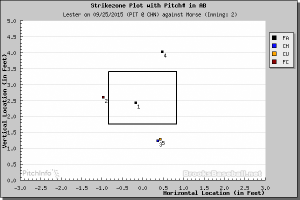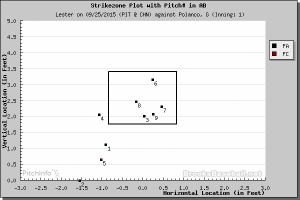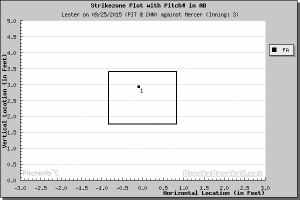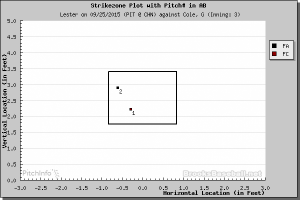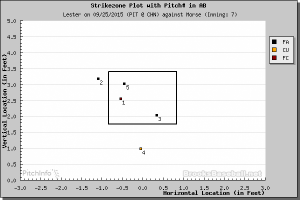Date: September 25, 2015
Opponent: Pittsburgh Pirates
Location: Wrigley Field
Introduction
“If I didn’t have bad luck, I’d have no luck at all.”
-Michael Gary Scott
Oh, how sweet it would have been.
Jon Lester was very good on Friday afternoon, just like he has been for the majority of 2015. It would have been so fitting that the man whose signing last winter signaled the Cubs arrival as contenders would be the one who earned the victory as the team clinched. As has been the case so often this season, though, a lack of run support and one or two mistakes with his four-seam fastball doomed Lester to close loss/no-decision hell. The celebration would have to wait another day.
What Lester did do, however, was what he has done all year: keep his team in the game, this time with an outstanding seven innings. That is worth celebrating. And in two start in 11 days against one of baseball’s best teams, Lester put up remarkable numbers:
| IP | K | Baserunners | WHIP | ERA | OPS | Whiffs |
| 16.0 | 15 | 13 | 0.813 | 1.69 | .496 | 23 |
Despite the outcome, Friday was mostly good. Lester got ahead of Pirates hitters consistently (16 of 25; 64 percent). He was fairly economical, needing more than 17 pitches in an inning just once. Lester was also able to get the Pirates to chase pitches out of the strike zone, inducing seven whiffs on pitches outside of the zone. He had just one 2-and-0 count and one 3-and-1 count, and faced just four batters over the minimum.
As you will see in the Pitch Breakdown, Lester did struggle to put away batters at times, and throw the ball by hitters with his four-seamer. At best, it allowed Pirates hitters to extend at-bats. At worst, it led to four of the five hits, including both run scoring plays. Two hits came with two strikes, and the second run was driven in by the opposing starting pitcher.
The Pirates have been on an offensive roll lately, but then, four games at Coors Field will do that for a team. Indeed, they’ve scored 50 runs in nine games, 33 of those coming in four games in Denver. In the past week or so, Starling Marte, Neil Walker, and Pedro Alvarez have each hit two home runs. Andrew McCutchen has received 14 (!) free passes for an okay 41.2 percent walk rate.
Lester, though, kept the Pirates in check for most of the afternoon. And save for a few misplaced fastballs, Lester was again dominant against one of the NL’s best offenses. It did not end with a champagne bath, but it was a worthy kick-off to clinching weekend. Want to learn more? Keep reading below.
Traditional Line
7.0 IP, 5 H, 6 K, 0 BB, 2 ER
Pitch Breakdown
102 pitches (72 strikes)
| Total | Velocity (Max) | AVG | SLG | BABIP | |
| Four-Seam | 48 | 93.3 (94.6) | .333 | .417 | .364 |
| Cutter | 22 | 88.2 (90.4) | .000 | .000 | .000 |
| Sinker | 12 | 92.5 (93.8) | .250 | .500 | .333 |
| Change-Up | 9 | 86.4 (87.9) | .000 | .000 | .000 |
| Curveball | 11 | 77.1 (79.6) | .000 | .000 | .000 |
The story of this start was his four-seam fastball, and it’s not a story with a happy ending. Lester went to his four-seam 15 of 37 instances with two strikes, but picked up just one strikeout. Of the five hits he surrendered, four came on the four-seamer, including both hits that led to runs.
Lester went to his curve on just 10.8 percent (11 of 102) of all pitches. However, 7 of 11 came with two strikes. And despite throwing so few curves, 4 of 12 whiffs and three of six strikeouts came off the pitch. All three strikeouts pitches came immediately following a fastball, demonstrating again just how effective Lester has been at sequencing and executing his and David Ross’s game plan. In two games against Lester, the Pirates have yet to put a curveball in play. On the season, opposing batters are slugging .298 against the curve, and just .192 with two strikes.
In two starts against the Pirates, Lester and Ross have favored his four-seamer, while going to his cutter and curve with less frequency, and his sinker and change with increased frequency. We break down this down a bit further below in the Keep-In-Mind section.
First, this Pitch Breakdown selection will deviate from the norm just a bit, as I wanted to highlight how Lester’s pitches are working in unison down the stretch. In one great sequence in the second inning, Lester used his fastballs to set up his off-speed and breaking pitches, and used his off-speed pitch to set-up his fastball, and the fastball to set up the curve.
With two out and nobody on, Michael Morse stepped to the plate:
Lester started Morse with two fastballs up:
1. 93.8 MPH four-seam fastball over the plate, foul ball
2. 89.7 MPH cut fastball up and inside, foul ball
Ahead 0-and-2, Lester went to the change up out of the strike zone, which Morse chased and fouled off:
3. 86.9 MPH change up low, foul ball
Still ahead 0-and-2, Lester and Ross attempted to get Morse to chase another fastball up in the zone:
4. 93.4 MPH four-seam fastball up, ball one
Morse laid off, but after showing him another high fastball, Lester came back with the off-speed out of the strike zone:
5. 78.0 MPH curve low, strike three swinging
First, Lester and Ross used the fastballs to set up the change up, which they used to set up another high fastball. That fastball then set up the curve for strike three. With the playoffs just around the corner, Lester is using his four-seamer, cutter, curve, and change as set up and finishing pitches. And as we detailed in this section last week, Ross does his homework. Below are Morse’s career slugging numbers against curves and change ups with two strikes:
Throughout his career, Morse has struggled with low curves and change ups with two strikes, and Lester and Ross attacked him accordingly. Cubs fans should be rejoicing at how in sync pitcher and catcher are in late September.
Trends
In the first three innings, Lester struggled to hit his spots and put away hitters. In late June, we detailed how Lester was missing his spots so dramatically that David Ross was compensated by “setting up with his foot planted firmly in the batter’s box, with his glove more than six inches off the plate.” As John Kruk noted at the time, the message was clear: “If you’re going to miss, miss in here.” It was simply a continuation of an issue that persisted throughout the season’s first half. As we wrote at the time, “We covered his stretch of allowing seven home runs in six starts off of missed fastballs, as well as the damage done by the Tigers on fastballs up and out over the plate.”
While the Pirates did not punish Lester’s mistakes as severely as hitters did in May and June, it was still effectively the difference in the game.
In Gregor Polanco’s opening at-bat, Lester needed nine pitches to induce a flyout to center field. Of the nine pitches, eight were four-seam fastballs. With the count full, Ross called three straight four-seamers low and away from Polanco, but Lester stayed up and in the zone with the fastballs. Polanco fouled off all three. The fourth four-seamer again missed and Polanco hit it hard, but right Dexter Fowler:
Polanco would be retired, but the multiple missed locations with fastballs foreshadowed what was to come on the day.
With one out and nobody on in the third inning, Jordy Mercer came to the plate. Mercer entered the game hitting .303/.378/.406 against lefthanders, and slugging .539 against first pitch four-seam fastballs. Nevertheless, Ross called for a four-seamer low and inside, but the 94.7 MPH fastball came up in the zone. Mercer lined the pitch to the gap in left center for a double:
The very next batter was Geritt Cole, who entered the game with eight hits this season, but also owned a -7 OPS+. On the first pitch, Cole swung through an 88.2 MPH cutter on the inner half of the plate. Ahead 0-and-1, Lester and Ross attempted to come further in and low with a 94.3 MPH four-seamer. However, the pitch stayed up and Cole hit the ball back up the middle for the game’s first run:
Lester has struggled with fastball location at various times this season, only to regain his form. He’s had his difficulties against the Pirates, sure, but Lester was usually able to mitigate the damage. While it is not cause for panic, it is worth watching with October coming fast.
Key At-Bat/Sequence
Inning: Seventh Inning
Score: 1-1
Situation: Keon Broxton on second base
Batter(s): Michael Morse
An extended Pitch Breakdown and Trends sections mean a truncated Key At-Bat/Sequence section. As we covered above in the Trends section, Lester had difficulty locating his fastballs, and it reared its ugly head in the seventh inning. With one out and a runner on second base, Morse stepped into the batter’s box. Morse’s overall 2015 has been below league average, but he has been slightly better than usual against left-handed pitchers (.254/.338/.365).
Like in Morse’s second inning at bat, Lester started him with a fastball over the plate, a cutter this time, which he again jumped on and fouled off. Ahead 0-and-1, Lester came way up and in with a four-seamer taken for ball one. With the count even, Lester hit the outside with a 93.0 MPH four-seamer for strike two.
Now 1-and-2, Lester and Ross had Morse’s first at-bat in mind when they went with a 78.7 MPH curve low and out of the zone. This time Morse kept his bat on his shoulder. With the count even, Lester came up in the zone with a 93.1 MPH four-seamer, much like Morse’s first at-bat, but this time in stayed in the strike zone and he grounded the pitch into right field for the go-ahead run:
With the game’s go-ahead in run scoring position, Lester went back to what worked so well in the second inning. Lester won the first battle, but Morse won the second time around.
Keep-In-Mind
A rare, two-part collector’s edition of the KIM(c) section:
1. Lester is receiving 3.52 runs per game in runs support, which is fifth worst among NL starters. The offense has scored 10 runs in his past four starts. We have exhausted dozens—possibly many dozens—of words on Lester’s poor offensive luck, but we’ll boil it down to this: the Cubs have three or fewer runs in 19 of his 31 starts. Even when a pitcher posts a 3.43 ERA, 3.88 DRA, and 3.02 FIP, he will be hard pressed to post better than 10-12 record. Just remember that come the postseason, when national broadcasters paying attention to Lester for the first time in 2015 point to the fact he won just 10 (or 11 or 12) games as proof of his first year struggles in Chicago.
2. Lester might very well see Pittsburgh again in 2015. So, how can we expect him to approach Pirates hitters? Below is his pitch frequency compared to his season averages:
| Pitch | vs. Pittsburgh | Season Average |
| Four-Seam | 47.42% | 42.45% |
| Cutter | 21.13% | 26.50% |
| Sinker | 8.92% | 10.57% |
| Curve | 12.68% | 15.36% |
| Change Up | 9.86% | 5.09% |
Expect Lester and Ross to lean heavy on the four-seamer, while his change up is used with increased frequency. But as we detailed above in the Pitch Breakdown section, do not be surprised if he uses all of his pitches early and late in counts.
Conclusion
Lester was very good on Friday. Unfortunately, some difficulty locating his four-seamer and continued bad luck in the run support department kept Lester (and the Cubs) from a victory. Still, his numbers in five September starts have been remarkable:
| AVG IP | WHIP | ERA | K% | BB% | AVG | OBP | SLP | BABIP |
| 6.8 IP | 0.882 | 2.65 | 25.2% | 5.5% | .195 | .246 | .340 | .250 |
Despite some hiccups with his four-seamer, he’s peaking with all of his pitches. His curve remains an effective strikeout pitch, his cutter nearly unhittable, and his change-up continues to emerge late in the season. He can go to all five pitches early and late in counts. Start number 31 did not go Lester’s way, and it would be another 24 hours before he was drenched in champagne, but it was still full of positives. And make no mistake, the 2015 Cubs would not be here with Jon Lester.
Season to Date
10-12, 3.43 ERA (3.88 DRA), 1.152 WHIP, 24.7% K, 5.9% BB
Next Start
Wednesday, September 30 at Cincinnati Reds
Lead photo courtesy Jerry Lai—USA Today Sports.

